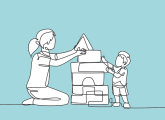Truly enabling environments, be they indoors or out, allow children to experiment free from the fear of failure.
Enabling environments should be age-specific, appealing to children’s interests, making them feel happy, challenged, safe and secure.
They should be places where they can confidently play and learn. However, some of the best enabling environments will provide enriching and exciting spaces for children (and adults) of any age, either due to their nature or how professionals have organised them (or a combination of both).
As children learn so much through exploring the environment and child-led activity, it’s important that we create an environment that is interesting, exciting and poses challenges.
With a well-thought-out or chosen environment, children will be able to experiment, problem-solve, push themselves, use mathematical concepts, use their communication skills and be active with a minimum of input from adults.
Margaret McMillan, pioneer of the British nursery school, said, ‘We are trying to create an environment where education will be almost inevitable’ (Hay, 2014).
This is a simple explanation of an enabling environment. If it is interesting, exciting, enticing, and encourages exploration, creativity and experimentation, it will enable learning.
When considering creating an enabling environment, you will need to take into account the emotional environment, the indoor environment and the outdoor environment.
An environment is not only the physical areas we expose children to, but also the people who are in it (other children, parents/carers and staff).
Lots of things can affect our emotional environment. This includes how parents/carers and staff interact, whether children feel safe, secure and cared for, and if there is an underlying feeling of positivity or negativity in the space.
In effect, relationships are what constitute the emotional environment. This includes the relationship between parents/carers and staff, staff and children, how people behave and speak to each other, how we treat people and how inclusive it is.
When children feel, safe, secure and happy in an environment that responds to their individual needs they are more likely to feel comfortable trying new things. They will push themselves and generally relax into enjoying their day.
This opens them up to learning so many new things and allows us to challenge them physically, emotionally and cognitively.
One of the best ways for children to learn is for them to feel able to make mistakes and persevere until they get it right.
Children will only be willing to do this if they are in a setting that has an emotional environment that encourages and supports all to explore and try new things.
It is therefore important for settings to have an ethos that supports positivity about failure. Nothing is wrong unless it will lead to someone getting hurt. Trying something new is more important than sticking to your comfort zone.
Much of this ethos will be discovered through adult role-modelling. We should allow ourselves to make mistakes, learn from them and try again. Aim to be positive and allow children many opportunities for self-directed play and learning.
Indoor spaces need to be interesting, accessible and flexible to accommodate children’s changing interests and needs.
Ensure there are spaces where children can be active and allow children to have an input into how you organise the space.
If you have limited space, consider activities such as dancing, active stories and yoga. These do not require a lot of space yet significantly raise heart rates and allow children to learn at the same time.
Children should be outdoors as much as they are indoors, if not more. They need a balance of self-directed and adult-led activity time.
When children are outdoors they can play and explore without many of the restrictions we so often place on them.
What they will encounter in nature is generally open-ended and will spark their imagination. This encourages them to discover and learn through their senses, leading to natural physical and cognitive development.
Children can experience many things we expose them to indoors, but often on a larger scale. This can be great for little hands that have not developed dexterity and fine-tuned their fine motor skills, and for children who struggle to sit still and concentrate.
Creating an effective outdoor environment does not mean creating a pretty, tidy environment. Children love to explore wild spaces, enjoy messy play and be inspired by an array of what might appear to be junk.
It’s important not to place our aesthetic value on a space that we’ve created for children’s exploration and enjoyment.
We also do not need to create different learning areas for subjects such as mathematics and literacy. This is because children will constantly be learning if we expose them to an enriching outdoor environment.
When children play outside they learn about the effect they have on the world around them and how to be good to the environment.
They will learn all kinds of mathematical concepts from outdoor activities, from playing with sticks, to water play, to building dens.
They will develop their language and communication when role playing or problem solving with their peers.
And when they have finally built that bridge out of tyres and planks, they will feel so very good about themselves!
The provision of open-ended, non-prescriptive and adaptable resources will open up children’s learning experience and encourage them to use their imagination, problem-solve and experiment.
This article is an edited extract from Learning Through Movement and Active Play in the Early Years by Tania Swift (Jessica Kingsley Publishers, £14.99). This title explains the importance of physical activity for promoting young children’s learning and wellbeing.

Emotional wellbeing – Why empathetic connection is key
Editors picks
